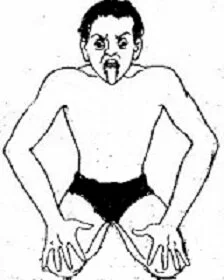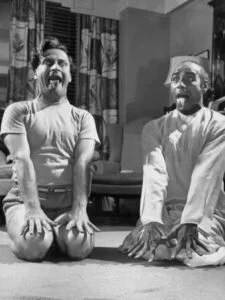 Simhasana (Sanskrit: सिंहासन; IAST: Siṁhāsana) or Lion Pose is an asana.
Simhasana (Sanskrit: सिंहासन; IAST: Siṁhāsana) or Lion Pose is an asana.
The name comes from the Sanskrit words simha (सिंहा) meaning “lion”, and asana (आसन, āsana) meaning “posture” or “seat”
The asana resembles a seated lion, hence the name Simha (lion in Sanskrit) asana. The practitioner’s facial expressions are modified to resemble a lion.
The Lion Face Gesture (Simha Mudra) is performed with other sitting asanas such as Padmāsana (Lotus Pose) or standing with the palms on the waist and the feet 6-12 inches apart.
Step by Step:-
The lion pose is pretty simple to execute. Although there may be a number of steps, this pose really requires very little effort. The lion pose steps are as follows:
- Sit with your legs folded under you so that your toes are pointing straight behind and you are sitting on your heels.
- Keep your spine straight but as relaxed as possible.
- Close your eyes and look to your third eye. (The third eye is a symbolic eye in the center of the forehead. In ancient India, it was assumed that the pituitary gland was located here, although now we know differently.)
- Closing your mouth, touch your palette with your tongue.
- Inhale a deep breath through your nose while your tongue is still touching your palette.
- Exhale in one violent move while sticking out your tongue and opening your jaws as much as possible. Also, your arms should be thrown out and stretched with your fingers splayed.
- Roar at the top of your voice while exhaling. The roar should be with a “Haa” sound and should not be a long drawn out one. Rather, it should be one violent explosion of breath that empties your lungs in the shortest time possible.
- Hold this pose for between 20 and 30 seconds.
- Do not inhale immediately after this pose; inhale after the specified 20 to 30 seconds.
- Repeat 5 or 6 times.
This asana (posture) gets its name from the way you stick your tongue out as far as possible and the way you hold your fingers splayed out, resembling a roaring lion.
Precautions:-
The Lion Pose is basically a stress reliever and can be practiced at any time and by anybody. There are usually no problems associated with practicing this pose because it does not require any complicated maneuvering of the body. However, if you suffer from any chronic illnesses or physical problems, it is best that you have a discussion with your doctor before you attempt any yoga posture.
Beginner’s tip:-
According to yoga, many problems that we face in our daily lives are due to a festering of anger and resentment. The Lion Pose effectively gives you an outlet for this negative energy. It does have its physical benefits, but as an analogy, you can compare it to putting on your gloves and taking your frustration out on a yoga punching bag! This pose is more a release of negative energy, which means that as long as you exhale violently, that is all that is required. The arms and shoulders are thrown outside violently and rigidly as an external manifestation of the release of the internal negativity. The pose can be repeated as many times as you wish, although if properly done, 5 to 6 times is sufficient.
Benefits:-
Physically the lion pose benefits the face and the throat, which is not usually benefited in other yoga poses.
- Face
- Eyes
- Throat
- Tongue
- Vocal cords
- Respiratory tract
- Abdomen
- Chest
- Diaphragm
- Fingers and hands
The violent stretching of the muscles of the face and the throat relieve tension. It is also believed to assist in relieving any infection of the throat and the respiratory tract. The tongue also receives unaccustomed exercise because it is stretched out fully outside the mouth.
Therapeutic applications:-
Therapeutic applications of the lion pose include:
- Curing bad breath
- Curing stutters
- Curing teeth grinding
- Curing clenched jaws
- Removing wrinkles
- Helping decreased burning in eyes
- Reliving back pain
- Relaxing tensed up neck muscles
- Improving the tone of the voice
The yoga Lion Pose also stimulates the platysma, which is a flat thin muscle in the front of the throat. This is the muscle that pulls down the corners of the mouth and also wrinkles the throat. It is believed that this exercise will help to prevent the sagging of the throat with age. Additionally, this pose helps promote good posture and in turn, increases confidence levels.
Variations:-
Since the Simhasana is such an easy pose, there are not too many variations. However, since the focus is on relaxation, different people make slight variations to the way they perform the pose. Listed below are some of the variations for lion pose.
Variation 1: Some people like to sit with their ankles crossed so that you sit on one heel instead of two.
Variation 2: As you are supposed to sit completely relaxed and because the most relaxed position while holding this sitting position is to have your hands on your knees, many people do that and just splay their fingers while exhaling.
Variation 3: Some use the same pose, but laugh instead of roar in order to reduce stress.
Variation 4: Instead of closing the eyes and looking to the third eye, this pose is sometimes held with the eyes open and looking to the tip of the nose.
The Simhasana has to be a violent release of tension. Many people follow a lackadaisical approach to this pose, with their exhaling not being violent enough. Even their throwing out their arms and splaying out their fingers is not done with much energy. This pose is an outlet for pent up anger and just as a half-hearted punch at a punching bag will not release much of your frustration, half-heartedly following the yoga lion pose will not give you many benefits.
